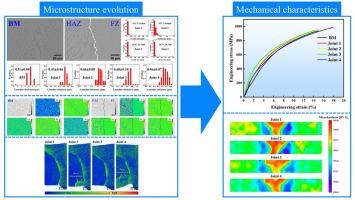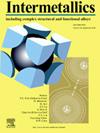电子束焊接 AlCoCrFeNi2.1 共晶高熵合金的显微组织和机械性能
IF 4.3
2区 材料科学
Q2 CHEMISTRY, PHYSICAL
引用次数: 0
摘要
AlCoCrFeNi2.1 共晶高熵合金(EHEA)的双相交错薄片结构使其具有高强度、优异的塑性和抗辐射性,因此作为一种结构材料具有相当大的潜力。电子束焊接(EBW)被用于制造热处理的 AlCoCrFeNi2.1 EHEA 的均匀焊接接头。实验结果表明,与 EBW 相关的快速冷却速率抑制了金属原子的扩散并提高了成核率,从而促进了熔合区(FZ)中更精细微观结构的形成。这明显改善了焊接接头的机械性能,焊接接头的极限抗拉强度超过了母材(BM)。在焊接热输入为 123.5 焦耳/毫米时,焊点的极限抗拉强度达到最大值 990.3 兆帕,焊点效率达到峰值 106.1%。与 BM 相比,热影响区 (HAZ) 的显微硬度下降了 9.4 % 到 11.4 %,而 FZ 的显微硬度则增加了 10.0 % 到 13.0 %。这项研究证明了在 AlCoCrFeNi2.1 EHEA 中使用 EBW 的可行性,为推动其实际应用提供了宝贵的见解。本文章由计算机程序翻译,如有差异,请以英文原文为准。

Microstructure and mechanical properties of electron beam welding of AlCoCrFeNi2.1 eutectic high entropy alloy
The dual-phase interleaved lamellar structure of the AlCoCrFeNi2.1 eutectic high entropy alloy (EHEA) endows it with high strength, excellent plasticity and radiation resistance, thereby offering considerable potential as a structural material. Electron beam welding (EBW) is employed to fabricate homogenous welded joints of the heat-treated AlCoCrFeNi2.1 EHEA. The experimental results indicate that the rapid cooling rate associated with EBW inhibits the diffusion of metal atoms and enhances the nucleation rate, thereby promoting the formation of a finer microstructure in the fusion zone (FZ). This markedly improves the mechanical properties of the welded joints, with the ultimate tensile strength of the welded joints exceeding that of the base material (BM). At a welding heat input of 123.5 J/mm, the ultimate tensile strength of the joint reaches a maximum of 990.3 MPa, resulting in a peak joint efficiency of 106.1 %. In comparison to the BM, the microhardness of the heat-affected zone (HAZ) exhibits a decrease of between 9.4 % and 11.4 %, while the microhardness of the FZ demonstrates an increase of between 10.0 % and 13.0 %. This study demonstrates the feasibility of employing EBW for the AlCoCrFeNi2.1 EHEA, providing valuable insights for advancing its practical applications.
求助全文
通过发布文献求助,成功后即可免费获取论文全文。
去求助
来源期刊

Intermetallics
工程技术-材料科学:综合
CiteScore
7.80
自引率
9.10%
发文量
291
审稿时长
37 days
期刊介绍:
This journal is a platform for publishing innovative research and overviews for advancing our understanding of the structure, property, and functionality of complex metallic alloys, including intermetallics, metallic glasses, and high entropy alloys.
The journal reports the science and engineering of metallic materials in the following aspects:
Theories and experiments which address the relationship between property and structure in all length scales.
Physical modeling and numerical simulations which provide a comprehensive understanding of experimental observations.
Stimulated methodologies to characterize the structure and chemistry of materials that correlate the properties.
Technological applications resulting from the understanding of property-structure relationship in materials.
Novel and cutting-edge results warranting rapid communication.
The journal also publishes special issues on selected topics and overviews by invitation only.
 求助内容:
求助内容: 应助结果提醒方式:
应助结果提醒方式:


